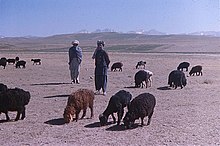Grazing
In agriculture, grazing is a method of animal husbandry whereby domestic livestock are allowed outdoors to free range (roam around) and consume wild vegetations in order to convert the otherwise indigestible (by human gut) cellulose within grass and other forages into meat, milk, wool and other animal products, often on land that is unsuitable for arable farming.
[1] Grazing has existed since the beginning of agriculture; sheep and goats were domesticated by nomads before the first permanent settlements were constructed around 7000 BC, enabling cattle and pigs to be kept.
Livestock grazing contributes to many negative effects on the environment, including deforestation, extinction of native wildlife, pollution of streams and rivers, overgrazing, soil degradation, ecological disturbance, desertification,[2] and ecosystem stability.
For an estimated 100 million people in arid areas, and probably a similar number in other zones, grazing livestock is the only possible source of livelihood.
[12] Ranchers and range science researchers have developed grazing systems to improve sustainable forage production for livestock.
This burned patch attracts grazers (cattle or bison) that graze the area heavily because of the fresh grasses that grow as a result.
[10][16] The Tallgrass Prairie Preserve in northeastern Oklahoma has been patch-burn grazed with bison herds for over ten years.
[19] In some cases, to re-establish traditional hay meadows, cattle such as the English Longhorn and Highland are used to provide grazing.
[21] Mob grazing is a system, said to be more sustainable, invented in 2002; it uses very large herds on land left fallow longer than usual.
Negative effects of grazing may include overgrazing, increased soil erosion, compaction and degradation, deforestation, biodiversity loss,[7] and adverse water quality impacts from run-off.
[25][26] Conservation grazing is the use of grazers to manage such habitats, often to replicate the ecological effects of the wild relatives of domestic livestock, or those of other species now absent or extinct.
[28] Grazing can reduce the accumulation of litter (organic matter) in some seasons and areas,[29] but can also increase it, which may help to combat soil erosion.
[32] An author of the Food and Agriculture Organization (FAO) report Livestock's Long Shadow,[33] stated in an interview:[34] Grazing occupies 26 percent of Earth's terrestrial surface ... feed crop production requires about a third of all arable land ...
In the Amazon basin alone, about 70 percent of previously forested land is used as pasture, while feed crops cover a large part of the remainder.
[verify quote punctuation]Much grazing land has resulted from a process of clearance or drainage of other habitats such as woodland or wetland.
[35] According to the opinion of the Center for Biological Diversity, extensive grazing of livestock in the arid lands of the southwestern United States has many negative impacts on the local biodiversity there.
[36] Cattle destroy native vegetation, damage soils and stream banks, and contaminate waterways with fecal waste.
The Environmental Protection Agency states that agriculture has a greater impact on stream and river contamination than any other nonpoint source.









